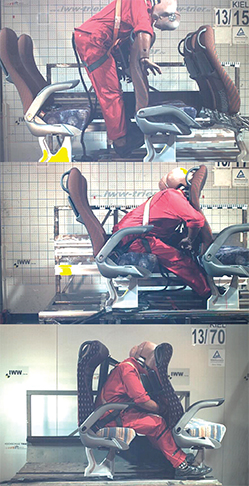The science of the three-point seat belt
By Jürgen Mill
Since the majority of new over-the-road buses will need FMVSS 210-compliant three-point-safety belts, it’s important to note that they are perhaps the greatest single device in making transportation safer.
When the first three-point seat belts became mandatory for motorcoaches in many European countries about 25 years ago, we started to develop seats that work in conjunction with seat belts to create the safest solution possible—not only for the passenger in the seat itself, but also for the surrounding riders. Following the principle that the most protective survival space is created when materials are allowed to bend rather than uncontrollably explode, we have focused our research on the “controlled plasticity” of the seat and the seat belt.
When it comes to FMVSS 210 testing, several reputable coach builders have started to require suppliers to not only meet but also exceed the NHTSA mandates by at least 10 percent. While this ensures important safety standards for the belt’s strength of anchorage and its ability to restrain the passenger in the seat, it does not take into account that the seat belt can actually fulfill another crucial function. By using its forward-pulling force, the shoulder part of the three-point belt can also initiate a calculated deformation of the seat back to reduce critical head and knee injuries to the passenger in the seat behind.

The engineered ‘warp’ of the back of the seat requires not only the use of highest grade materials that will reliably enter this state voluntarily without breaking but also the most rigorous quality management and consistent safeguarding of the Conformity of Production (COP). Even little variances in material behavior can add up, so it’s best to partner with a manufacturer with a healthy habit of ensuring the quality of materials throughout the entire manufacturing process at all times and at all production plants.
It has been a general challenge for seating manufacturers to extend the FMVSS 210 safety standards to slider seat models that accommodate passengers in wheelchairs. The seats, which seem notorious for the difficulties in installation and handling they present, need to show the reliability of a firmly installed seat yet be flexible enough to slide away effortlessly—all while complying with current seat-belt safety requirements. Using self-aligning, foot-operated technology with stainless steel legs has allowed us to offer a slider seat that does not only completely fulfill the NHTSA safety standards, but exceeds even the stricter FMVSS 210 requirements mandated by coach builder Motor Coach Industries, for example.
Don’t forget two of the most overlooked items when it comes to seat-belt safety in coach seats. It is preferable to opt for seat belts and anchorages that are not integrated into the seat foam itself, for the simple reason that it will take a lot more time and effort to repair or exchange a malfunctioning seat-belt system that is integrated into the seat (as it almost always involves removing the entire seat from the vehicle). Additionally, non-integrated seat belts also allow for the use of a height adjuster for smaller passengers and tend to stay cleaner because dirt cannot get trapped in inaccessible slots.
Because only the safest seats save lives, it is also important to ensure that the seat-belt buckles always close toward the aisle. While it tends to be a bit more involved for the seat manufacturer to deliver slightly different seats for each side of the aisle, it is worth ensuring that emergency personnel can access the belt buckle in the easiest and fastest way possible. Those seconds may make a crucial difference.
Jürgen Mill is senior VP of engineering and R&D at the global headquarters of the Kiel Group. Kiel is a trendsetting seat provider to transit systems around the world including seating solutions for buses and trains on the local, regional and intercity level. Visit www.kielna.com
